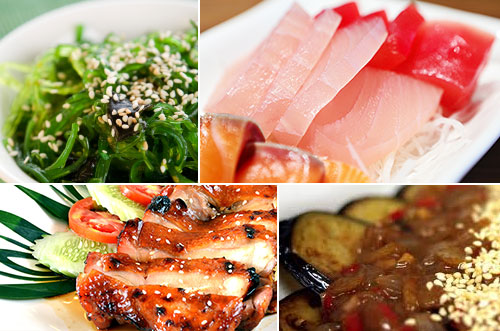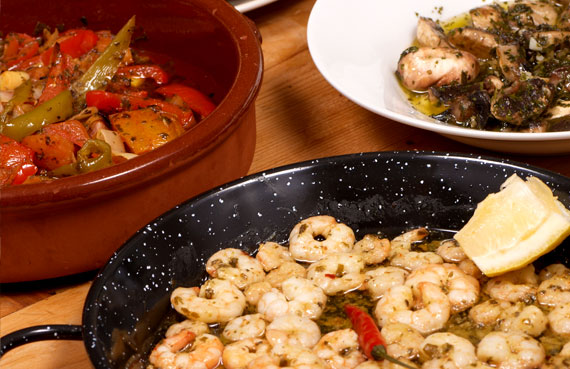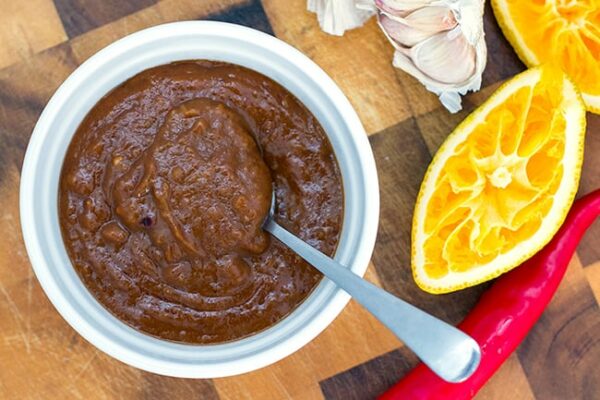
In this second instalment of Eating Out Paleo series I am covering Japanese. It’s known as a healthy cuisine – lots of fish, miso, vegetables and green tea – but the most common go-to dishes are actually almost always grain based and thus not Paleo friendly. So how do we go past sushi, ramen and gyoza – all of which I love tenderly – and still have a satisfying Japanese meal?
Depending on the Japanese food offering in your area, you might have a few healthy options to choose from. As with many other cuisines, when it comes to eating out you have to turn a blind eye on the cooking oils and fats used in preparation. Yes, you could ask the kitchen staff to cook your dish in butter or olive oil or with no fat at all but this exercise gets tedious and your friends might stop inviting you out. Otherwise, here is a list of acceptable Japanese dishes I’ve compiled from a few common menus.
Things to avoid:
– Ramen and udon soups with noodles – the soup bases are probably ok but most noodles are made with wheat, rice or buckwheat flour. If you are going for a noodle dish, stick to rice or buckwheat noodles to avoid gluten.
– Rice based dishes such as sushi and fried rice. If you’re getting grilled chicken or salmon dish, ask for no rice and some vegetables instead. If you must have some rice, remember that it’s one of the more benign grains and every now and then it won’t do any long term damage.
– Anything deep-fried in batter like tempura prawns or vegetables, chicken or pork katsu (schnitzel like dish), chicken karaage (as much as I love thee). This way you will avoid flour and any nasty oils they might be soaked in.
– Be careful with soy based foods like agedashi tofu and soy sauce. Most soy sauces contain wheat so if you’re trying to avoid gluten all together, it’s best to carry around your own bottle of wheat free soy sauce or coconut aminos. BUT having said that, the amount of sauce you consumer as a condiment is really not a large amount of soy and will not harm you. Most people should be more concerned with the processed, unfermented soy products such as soybean oil and soy milk.
– Teriyaki sauces are often loaded with sugar and salt so be aware of how much you’re consuming. Grilled teriyaki chicken is still better than a massive plate of sushi though.
Things you should be ok with:
– I hope you like raw fish because sashimi is your best friend when it comes to Japanese food. Fresh slices of raw tuna, salmon and king fish with wasabi and your wheat free soy sauce or ponzu dressing…ummm…delicious!
– One step up from raw food is tataki – a Japanese carpaccio equivalent. Beef or fish is marinated in vinegar based sauce, seared quickly on the outside and then sliced thinly. It is usually served with a subtle citrus or vinegar based dressing and grated ginger.
– Wakame – edible seaweed – is usually served as salads and in soups. It’s highly nutritious and contains high levels of omega-3 fatty acids.
– Yakitori is another great choice. Although traditionally yakitori refers to grilled chicken skewers, the name is now often used for skewered grilled food in general. Succulent bite size pieces of meat are usually seasoned with salt or tare sauce made with mirin, sake, soy sauce and sugar. Besides chicken thighs, you will often find chicken heart, livers, meatballs, beef, lamb, enoki mushrooms wrapped in bacon, green okra beans, asparagus, and mushrooms. Stick to simple seasoning of salt.
– Miso based dishes are actually ok. Miso is made from fermented soy beans which lose their lectin and phytates content during the fermentation process. That means you can have miso soup (avoid tofu bits floating inside) and miso eggplant (although it is usually deep-fried and who know in what oil).
– Edamame – young green soy beans are not the best choice but they are better than other unfermented soy based dishes or mature beans because they contain lower levels of phytoestrogens and mostly monounsaturated fats. Read Mark Sisson’s take on edamame here
– Grilled beef, salmon, and chicken teriyaki – not fantastic due to soy and sugar used in the sauce but a better choice nevertheless.
– Other common options are grilled eel, tuna or salmon & avocado salad, shabu shabu (which consists of shared tasty broth and a side of meats and vegetables that you cook yourself), roasted pork belly, cabbage salad, pickles, tamagoyaki (Japanese rolled omelette) or okonomiyaki (Japanese omelette pancakes, although it might have flour).
– When you visit a sushi train you don’t have to stick to moving plates. Order from the menu if you can’t see anything without rice.
So there it is, Japanese paleo dining in a nutshell. I hope it helps you make better choices next time you visit a local izakaya or sushi train.
Irey 🙂






Ultimate paleo Japanese food : Horumon-yaki